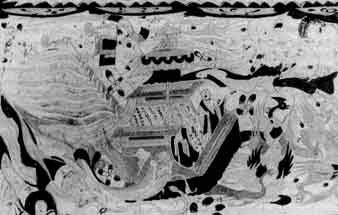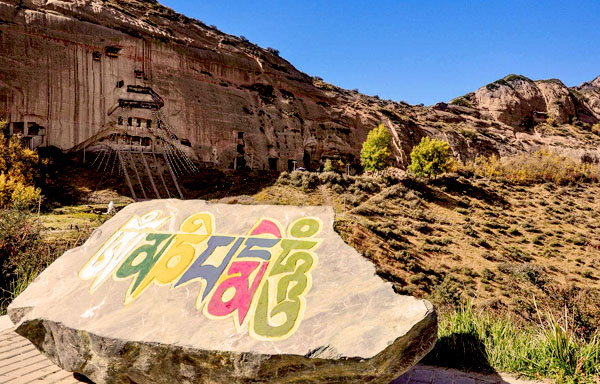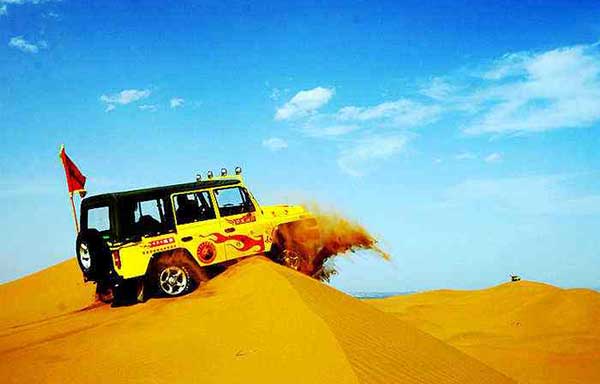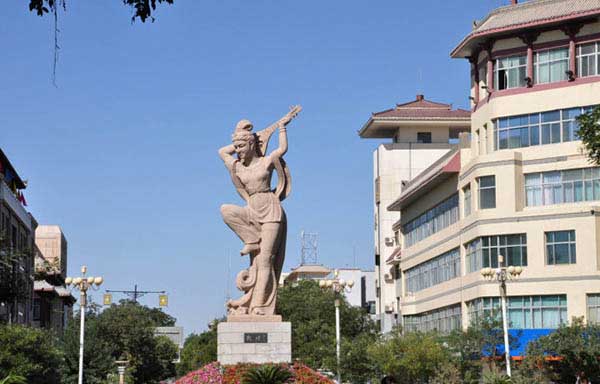- By admin
- In DunhuangArt
- 2017-12-11
Style and Artistry of Dunhuang Art
 Cave No. 296, Northern ZhouThe introduction of traditional Chinese mythological themes has created in the Mogao murals a vivid portrayal of flying figures and floating clouds of paintings bursting with dynamism. These new themes also call for a new technology of the swift drawing of ochre-red outlines and light-black contour lines. The iron-hard lines finalizing the contours show elegance, vigour and freedom of expression. The ochre background was gradually replaced by white which stands in clear contrast to the intermingling of vermilion, violet, blue and green. A special feature is the introduction of the traditional Chinese colouring technique of the "heartland" in the murals. Two red patches are painted on the cheeks of the figures to demonstrate health and vitality, contributing also to a three-dimensional effect. This is a different approach producing an effect quite opposite to that of the three-dimensional method introduced from the Western Regions during the Northern Liang and Northern Wei. Both these techniques of colouring existed side by side for a fairly long period of sixty to seventy years.
Cave No. 296, Northern ZhouThe introduction of traditional Chinese mythological themes has created in the Mogao murals a vivid portrayal of flying figures and floating clouds of paintings bursting with dynamism. These new themes also call for a new technology of the swift drawing of ochre-red outlines and light-black contour lines. The iron-hard lines finalizing the contours show elegance, vigour and freedom of expression. The ochre background was gradually replaced by white which stands in clear contrast to the intermingling of vermilion, violet, blue and green. A special feature is the introduction of the traditional Chinese colouring technique of the "heartland" in the murals. Two red patches are painted on the cheeks of the figures to demonstrate health and vitality, contributing also to a three-dimensional effect. This is a different approach producing an effect quite opposite to that of the three-dimensional method introduced from the Western Regions during the Northern Liang and Northern Wei. Both these techniques of colouring existed side by side for a fairly long period of sixty to seventy years.
During the Northern Zhou, Yu Yi, the Duke of Jianping, succeeded Yuan Rong as provincial Governor of Guazhou. The two did their utmost in popularizing Buddhism in Dunhuang; a reference to which may be found in "Li jun xiu Mogaoku fokan bei" (Inscription of Mr. Li's exploits in building Buddhist shrines at Mogao).
Although the political power of the Northern Zhou was brief, quite a number of caves were cut during this period while story paintings reached new heights. The stories have rich and complex plots, compact compositions and free and invigorating line drawings of muscular figures. The refreshing colours add to the concentrated flavour of life evident in the paintings.
The figures, costume and decoration betray the influence of the "heartland" style. In the representation of character, the style of "heartland" China blended well with earlier styles of Western Regions creating new images/dunhuang of "rounded and handsome faces", to be seen in the example of the figures of the laity and donors in the illustrations of stories. The most striking feature of the Northern Zhou is the sudden appearance of figures of Buddhist themes in Western style. The Bodhisattvas have plump faces and short and sturdy bodies either with a semi-nude upper torso or wearing a kasaya, a dhoti around the loins and a broad shawl draped over the shoulders. Particularly deserving of notice is the colouring of the faces --- white nose, white eyes or white strips extending from the eyes to the eyebrows, white teeth and white chin. Thick white powder is also used to highlight the cheeks, the forehead and the flat belly, making the figure look fat. This was a new feature, not to be found in the early cave murals of Mogao, Tianti Hill and Binglingsi. The style may be traced back to the Kuca cave murals; in colour and characterization it is identical to the style found in Kizil caves. As the style of the early murals of Kuca appeared in the Dunhuang caves during the last years of the Northern Dynasties, scholars have for many years mistakenly believed these Northern Zhou caves to be ones from the Northern Wei.
There is a specific reason as to why the old forms made a reappearance. It was primarily due to the close ties between the Zhou Emperor Wu and the foreign nationalities in the western and northern neighbourhood of the country. After his marriage to the Turkish princess, Ashina, there was an inflow of music, dance and arts from the Western Regions into "heartland" China through the Hexi Corridor. A parallel stream of culture and artefacts, particularly exquisite silks, flowed from China to the Western Regions. Such brisk cultural and economic interchange coincided with Duke Jian Ping's vigorous patronage of the construction of caves in Dunhuang. Therefore, it is but natural that the style of early Kizil murals should once again spread to Dunhuang. However, this style proved as ephemeral as the political fate of the Northern Zhou which lasted only for a brief span of ten odd years.
The Sui Dynasty ended the confrontation between the North and South China. The royal Sui patronised the construction of Buddhist shrines at Dunhuang. As a result, about 70 odd caves were cut out at Mogao within a short span of about 30 years. Illustrations of Hinayana Buddhist sutras from the west were gradually replaced by those of Maha Buddhism imported from "heartland" China. The Buddhist figures gradually took on the uniform style of the Sui Dynasty after initial bold experiments.
Related destinations
Why Choose Us?
We are the top Silk Road tour operator based in Dunhuang, China. We focus on providing well designed Silk Road China Tours with resonable price and thoughtful service.
- Easy & carefree booking
- The best value
- Great travel experience
- Locally operated
Hot Tours
-

6 days Gansu tour to Binglingsi, Xiahe and Langmusi
Tour type : Private tour Price : from *** Destinations : Lanzhou - linxia - Xiahe - Langmusi - Hezuo - Lanzhou -

12 Days Gansu Highlights Tour
Tour type : Private tour Price : from *** Destinations : Xian – Tianshui – Lanzhou – Xiahe – Langmusi – Hezuo – Zhangye – Jiayuguan - Dunhuang -

10 Days Silk Road Classic Tour
Tour type : Private tour Price : from *** Destinations : Xian - Zhangye - Jiayuguan - Dunhuang - Turpan - Urumqi -

5 Days Zhangye - Alxa youqi Highlights Tour
Tour type : Private Tour Price : from *** Destinations : Zhangye - Alax youqi - Zhangye


